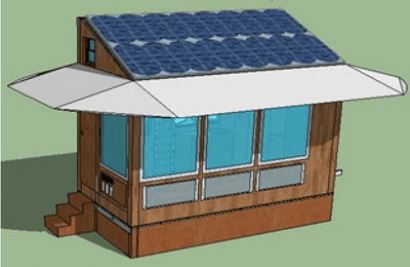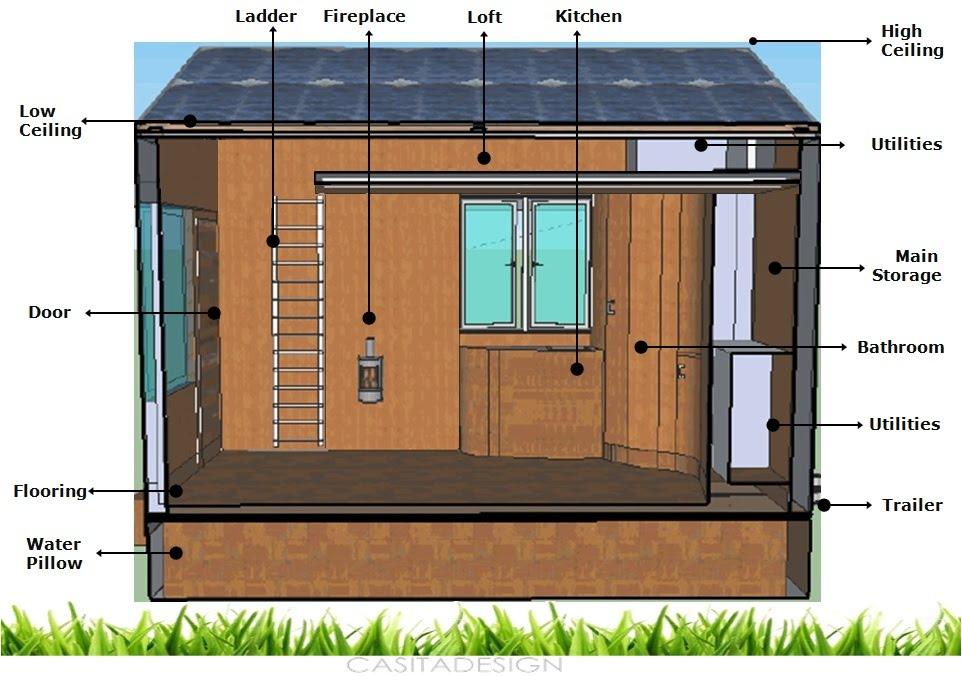
The greenest square foot is the one you don’t build – this is the motto of the Tiny House Project, an undertaking by students at Northwestern University to construct a minimalist off-net house providing all the necessities of a home, and none of the frills. The 12 square meter (128 square foot) Northwestern house is unique compared with other tiny houses in that it may be the only one that is 100 percent off the electric grid while meeting all of its water needs through a sophisticated rainwater collection system.
Many of us in the renewable energy business are familiar with the work of architect Sarah Susanka, who has championed the “Not So Big House” through numerous books and lectures. The tiny house movement takes the not-so-big concept a step further by creating the smallest possible space someone can live in while still having enough room to cook, sleep, and relax. Many of these small houses are only around 50 square meters (538 square feet) in size, and some are actually less than 10 square meters (108 square feet), about as roomy as a standard bathroom. The Northwestern students were inspired by social activist Jay Schafer, founder of the Tumbleweed Tiny House Company, one of the original tiny house manufacturers.
The Northwestern house has just about everything anyone would need to live “comfortably” – a small kitchen, bathroom, living room, storage area, sleeping loft, and even a fireplace! The house also features an awning for shade, a shower, multiple windows, and a composting toilet. And while the photovoltaics (four 72-cell MEMC panels rated at 280 Watts each) don't come anywhere close to satisfying the energy requirements of typical home, they provide sufficient power for a small refrigerator (NOVAKOOL R-4500 rated at 480 Watt-hrs per day), for lighting, and for a laptop computer.

Built by students, the Tiny House Project nears completion on the Northwestern Campus in Evanston, Illinois (US).
A unique feature of the house is its rainwater collection system, which provides, on average, about 32 liters (8.4 gallons) of water per day throughout the year. The roof and awnings collect rainwater, and a gravity-fed gutter system transfers the water to a 1,500 liter (400 gallon) “storage pillow” located beneath the house. A small 8 liter per minute (2 gallon per minute) pump then moves the water through a filtration system and into a pressurized tank that feeds a solar hot water heater. By using the awnings to help collect rainwater, the effective collection surface is increased to about 30 square meters (320 square feet), two and one-half times the house’s footprint.

All the necessities of a home are squeezed into the space above a 12 square meter (128 square foot) footprint.
While the house’s design has many unusual and innovative technological features, the design team also points to the teaching value of their project:
Beyond the technology is the philosophy our home teaches. It internalizes the production of resources, which means you become part of the resource generation methods. It forces you to understand the processes included in the luxuries of our lives. It lifts the veil and makes you respect the blessings we’ve been given.
In other words, if you live in a tiny house, you become more aware of our affluent society and the resources we consume, and perhaps, you appreciate more the luxuries that the rest of us take for granted.
Next time you are contemplating how to reduce your carbon footprint by downsizing your living space, don’t just think small – think tiny!
[For more information on the Northwestern House, see Living Little: Tiny House is a Model of How Every Inch - and Lack of Inches - Matters in Sustainable Living. And for an excellent New York Times story on small houses, see The Next Little Thing.]
[Images: Courtesy of Northwestern University, Tiny House Project]

